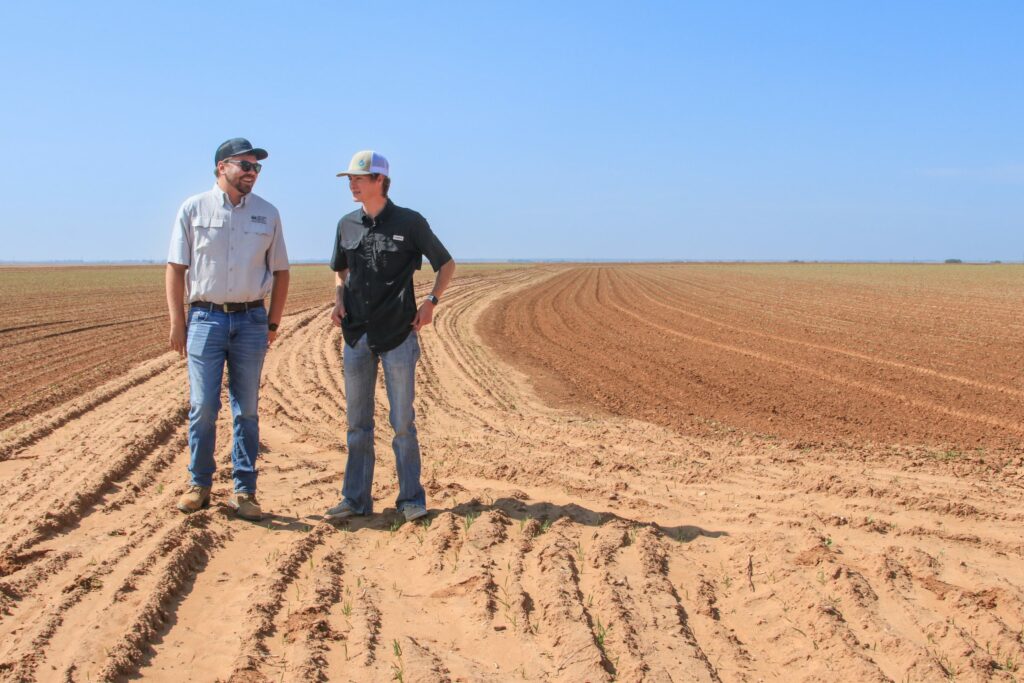Farmers and ranchers are continually searching for the most up-to-date techniques and technologies to increase production efficiency on their land, while conserving natural resources. One federal agency is key in helping them to discover these innovations.
The Natural Resources Conservation Service (NRCS) in Texas is helping people help the land by delivering conservation solutions and technical support that protect natural resources and feed a growing world.
Reed Poling, field engineer for NRCS in Texas, grew up on a corn and soybean farm in Ohio, and knows first-hand the necessity of innovation in agriculture. NRCS engineers work in conjunction with field conservationists to plan and apply practices on the ground. Poling has spent the last several years helping farmers and ranchers in the Texas Panhandle find innovative solutions to alleviate resource concerns such as controlling erosion and conserving water on their land.
“When we work with a farmer or rancher, there really is no cookie-cutter solution,” Poling said. “Every field is different.”
When assisting a farmer or rancher, Poling said NRCS takes a whole-solution approach. This ensures that the landowner receives a result that will benefit their operation, all while taking steps to protect natural resources.

Basin Terraces
One technique Poling has helped farmers implement on their farms to protect the topsoil and reduce runoff is the establishment of basin terraces, which is important for land with a slope. In years past, Poling said parallel terraces were more popular.
“With parallel terraces you would build on parallel lines across the field that follow the contour of the land and sometimes had sections of the terrace that didn’t fit the land very well,” Poling said. “They did help with stopping rainfall runoff moving from the top of the field to the bottom, picking up energy and taking soil with it.”
Poling said basin terraces are now used more and are different in that they are built with a level channel across the field and end closures designed to store a specific amount of runoff. They are generally larger than parallel terraces and spaced further apart. They break up the slope of the land to limit erosion.
Basin terraces help protect water quality by reducing erosion and preventing sediment from reaching nearby bodies of water. They also manage runoff and benefit the farmer.
“When you look at putting terraces and things of that nature in a crop land field, you keep the topsoil on the land, which is the most productive part of a farm,” Poling said.
In addition to retaining beneficial topsoil, Poling said basin terraces help hold more water in the field, which can ultimately increase available water for a farmer’s crop.

Roof Runoff Structures
Another effective technique and conservation practice Poling has assisted producers to put in place is roof runoff structures.
“Basically, it’s installing gutters on a barn and then having a tank underneath that barn to help capture the rainfall that hits those roofs,” Poling said.
With semi-arid climate of West Texas and declining Ogallala Aquifer, Poling said the water captured from these roof runoff structures can come in handy. This supplemental water can be used to water livestock or for spray applications on the farm, which can save producers money in the long run, too.
The Vital Component: Innovation
Innovation is a vital component of a successful farm or ranch for many reasons. Whether it is related to crop prices, weather, equipment breaking down or finding labor, Poling said that farming changes every year.
“The more innovative and flexible a farmer can be with their operation, the more chance of success and staying in business, regardless of the size,” Poling said.
Innovation also helps magnify conservation efforts. Especially in the case of West Texas, Poling said any conservation practice that can help conserve water and protect the aquifer is something worth looking into.
“Anything we can do to help extend that life or even keep that water for as long as we can is great,” Poling said.
Farmers and ranchers are working to do just that. In fact, Poling said he works with some of the greatest farmers and ranchers who are conservation conscious and care for the land.
“They understand that this is a business, and this is something that is for their family,” Poling said. “But also, it’s something that everyone across the Panhandle can be proud of. They’re producers for the country.”
